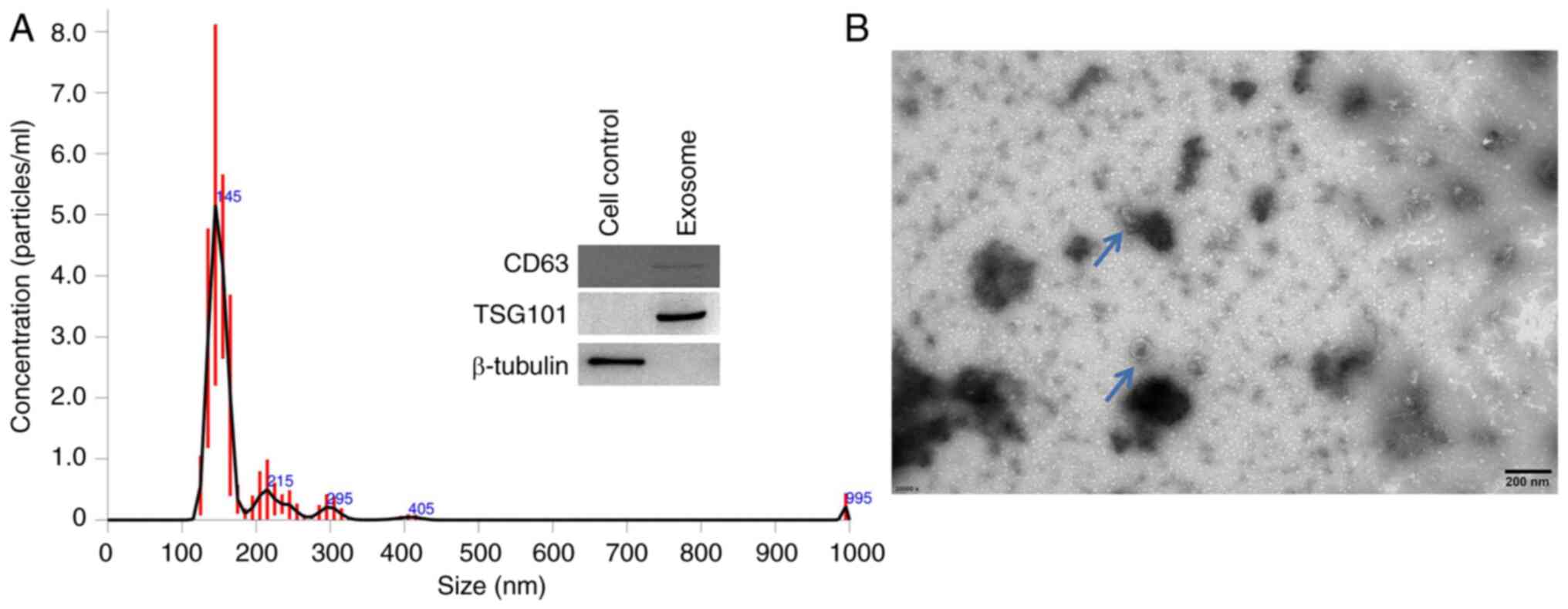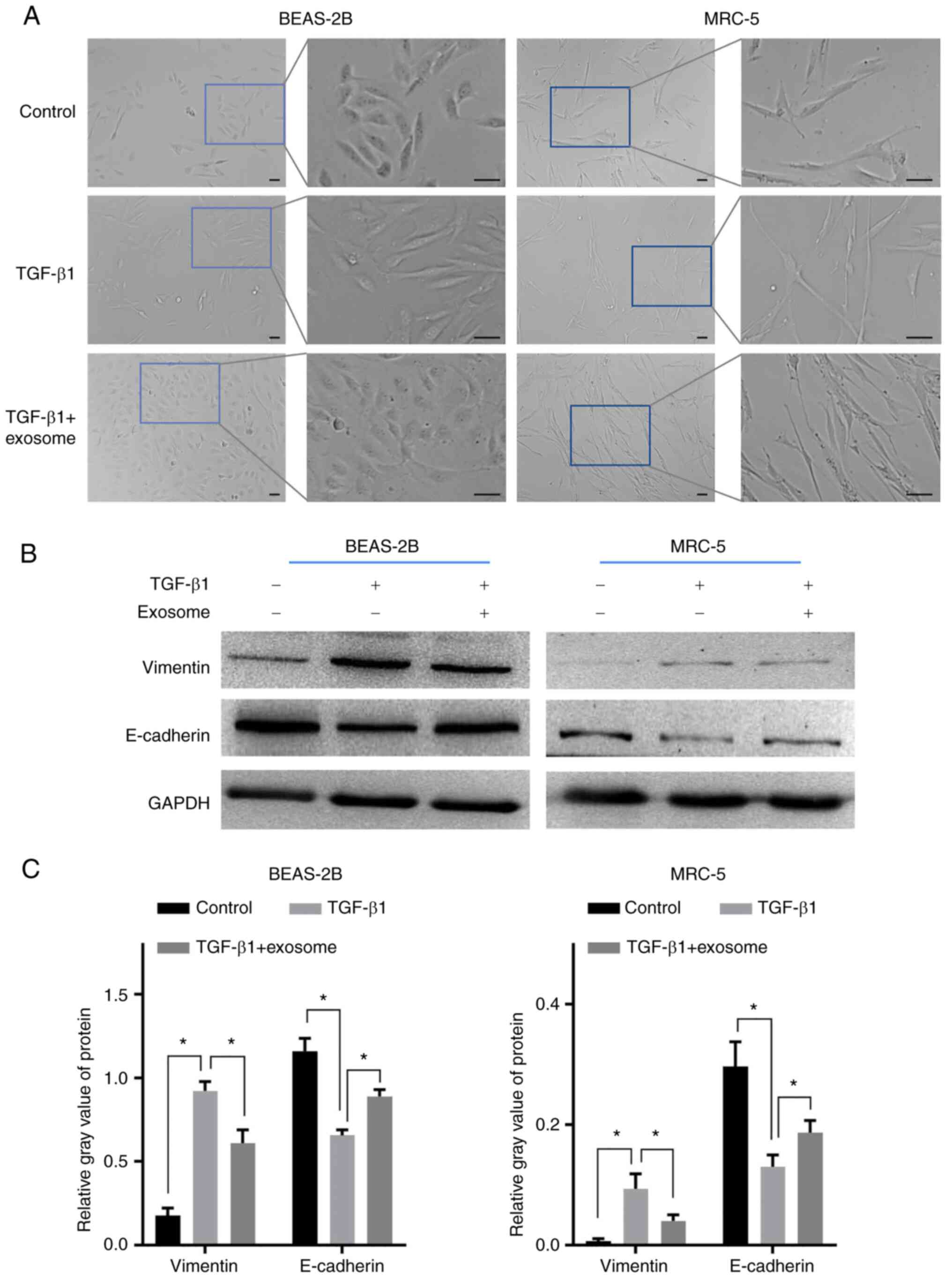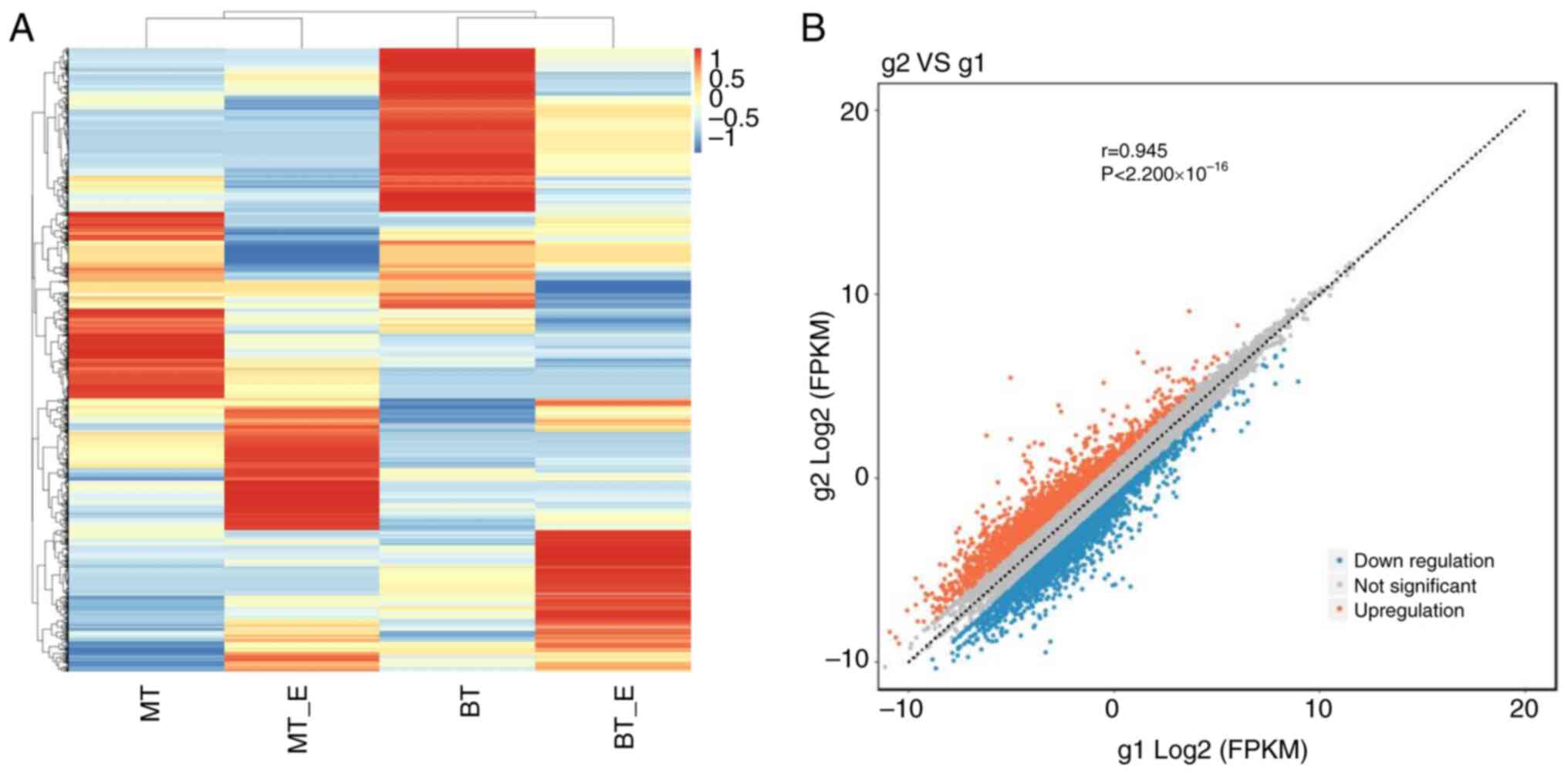|
1
|
Abuserewa ST, Duff R and Becker G:
Treatment of idiopathic pulmonary fibrosis. Cureus.
13(e15360)2021.PubMed/NCBI View Article : Google Scholar
|
|
2
|
Glass DS, Grossfeld D, Renna HA, Agarwala
P, Spiegler P, DeLeon J and Reiss AB: Idiopathic pulmonary
fibrosis: Current and future treatment. Clin Respir J. 16:84–96.
2022.PubMed/NCBI View Article : Google Scholar
|
|
3
|
Mattoo H and Pillai S: Idiopathic
pulmonary fibrosis and systemic sclerosis: Pathogenic mechanisms
and therapeutic interventions. Cell Mol Life Sci. 78:5527–5542.
2021.PubMed/NCBI View Article : Google Scholar
|
|
4
|
Spagnolo P, Kropski JA, Jones MG, Lee JS,
Rossi G, Karampitsakos T, Maher TM, Tzouvelekis A and Ryerson CJ:
Idiopathic pulmonary fibrosis: Disease mechanisms and drug
development. Pharmacol Ther. 222(107798)2021.PubMed/NCBI View Article : Google Scholar
|
|
5
|
Purghè B, Manfredi M, Ragnoli B, Baldanzi
G and Malerba M: Exosomes in chronic respiratory diseases. Biomed
Pharmacother. 144(112270)2021.PubMed/NCBI View Article : Google Scholar
|
|
6
|
Kadota T, Yoshioka Y, Fujita Y, Araya J,
Minagawa S, Hara H, Miyamoto A, Suzuki S, Fujimori S, Kohno T, et
al: Extracellular vesicles from fibroblasts induce epithelial-cell
senescence in pulmonary fibrosis. Am J Respir Cell Mol Biol.
63:623–636. 2020.PubMed/NCBI View Article : Google Scholar
|
|
7
|
Zhu L, Chen Y, Chen M and Wang W:
Mechanism of miR-204-5p in exosomes derived from bronchoalveolar
lavage fluid on the progression of pulmonary fibrosis via AP1S2.
Ann Transl Med. 9(1068)2021.PubMed/NCBI View Article : Google Scholar
|
|
8
|
Kadota T, Fujita Y, Araya J, Watanabe N,
Fujimoto S, Kawamoto H, Minagawa S, Hara H, Ohtsuka T, Yamamoto Y,
et al: Human bronchial epithelial cell-derived extracellular
vesicle therapy for pulmonary fibrosis via inhibition of TGF-β-WNT
crosstalk. J Extracell Vesicles. 10(e12124)2021.PubMed/NCBI View Article : Google Scholar
|
|
9
|
Samarelli AV, Tonelli R, Heijink I, Martin
Medina A, Marchioni A, Bruzzi G, Castaniere I, Andrisani D, Gozzi
F, Manicardi L, et al: Dissecting the Role of mesenchymal stem
cells in idiopathic pulmonary fibrosis: Cause or solution. Front
Pharmacol. 12(692551)2021.PubMed/NCBI View Article : Google Scholar
|
|
10
|
Hoang DM, Pham PT, Bach TQ, Ngo ATL,
Nguyen QT, Phan TTK, Nguyen GH, Le PTT, Hoang VT, Forsyth NR, et
al: Stem cell-based therapy for human diseases. Signal Transduct
Target Ther. 7(272)2022.PubMed/NCBI View Article : Google Scholar
|
|
11
|
Ha DH, Kim HK, Lee J, Kwon HH, Park GH,
Yang SH, Jung JY, Choi H, Lee JH, Sung S, et al: Mesenchymal
stem/stromal cell-derived exosomes for immunomodulatory
therapeutics and skin regeneration. Cells. 9(1157)2020.PubMed/NCBI View Article : Google Scholar
|
|
12
|
Zhang E, Geng X, Shan S, Li P, Li S, Li W,
Yu M, Peng C, Wang S, Shao H and Du Z: Exosomes derived from bone
marrow mesenchymal stem cells reverse epithelial-mesenchymal
transition potentially via attenuating Wnt/β-catenin signaling to
alleviate silica-induced pulmonary fibrosis. Toxicol Mech Methods.
31:655–666. 2021.PubMed/NCBI View Article : Google Scholar
|
|
13
|
Harrell CR, Miloradovic D, Sadikot R,
Fellabaum C, Markovic BS, Miloradovic D, Acovic A, Djonov V,
Arsenijevic N and Volarevic V: Molecular and cellular mechanisms
responsible for beneficial effects of mesenchymal stem cell-derived
product ‘Exo-d-MAPPS’ in attenuation of chronic airway
inflammation. Anal Cell Pathol (Amst). 2020(3153891)2020.PubMed/NCBI View Article : Google Scholar
|
|
14
|
Sengupta V, Sengupta S, Lazo A, Woods P,
Nolan A and Bremer N: Exosomes derived from bone marrow mesenchymal
stem cells as treatment for severe COVID-19. Stem Cells Dev.
29:747–754. 2020.PubMed/NCBI View Article : Google Scholar
|
|
15
|
Ma Q, Ma Y, Dai X, Ren T, Fu Y, Liu W, Han
Y, Wu Y, Cheng Y, Zhang T and Zuo W: Regeneration of functional
alveoli by adult human SOX9+ airway basal cell
transplantation. Protein Cell. 9:267–282. 2018.PubMed/NCBI View Article : Google Scholar
|
|
16
|
Lee C, Mitsialis SA, Aslam M, Vitali SH,
Vergadi E, Konstantinou G, Sdrimas K, Fernandez-Gonzalez A and
Kourembanas S: Exosomes mediate the cytoprotective action of
mesenchymal stromal cells on hypoxia-induced pulmonary
hypertension. Circulation. 126:2601–2611. 2012.PubMed/NCBI View Article : Google Scholar
|
|
17
|
Kropski JA and Blackwell TS: Progress in
understanding and treating idiopathic pulmonary fibrosis. Annu Rev
Med. 70:211–224. 2019.PubMed/NCBI View Article : Google Scholar
|
|
18
|
Takayama Y, Derouiche S, Maruyama K and
Tominaga M: Emerging perspectives on pain management by modulation
of TRP channels and ANO1. Int J Mol Sci. 20(3411)2019.PubMed/NCBI View Article : Google Scholar
|
|
19
|
Zuo W, Zhang T, Wu DZ, Guan SP, Liew AA,
Yamamoto Y, Wang X, Lim SJ, Vincent M, Lessard M, et al:
p63(+)Krt5(+) distal airway stem cells are essential for lung
regeneration. Nature. 517:616–620. 2015.PubMed/NCBI View Article : Google Scholar
|
|
20
|
R Core Team. R: A language and environment
for statistical computing. R Foundation for Statistical Computing,
Vienna, Austria, 2019.
|
|
21
|
Javellana M, Eckert MA, Heide J, Zawieracz
K, Weigert M, Ashley S, Stock E, Chapel D, Huang L, Yamada SD, et
al: Neoadjuvant chemotherapy induces genomic and transcriptomic
changes in ovarian cancer. Cancer Res. 82:169–176. 2022.PubMed/NCBI View Article : Google Scholar
|
|
22
|
Livak KJ and Schmittgen TD: Analysis of
relative gene expression data using real-time quantitative PCR and
the 2(-Delta Delta C(T)) method. Methods. 25:402–408.
2001.PubMed/NCBI View Article : Google Scholar
|
|
23
|
Liu P, Miao K, Zhang L, Mou Y, Xu Y, Xiong
W, Yu J and Wang Y: Curdione ameliorates bleomycin-induced
pulmonary fibrosis by repressing TGF-beta-induced fibroblast to
myofibroblast differentiation. Respir Res. 21(58)2020.PubMed/NCBI View Article : Google Scholar
|
|
24
|
Giebel B, Kordelas L and Börger V:
Clinical potential of mesenchymal stem/stromal cell-derived
extracellular vesicles. Stem Cell Investig. 4(84)2017.PubMed/NCBI View Article : Google Scholar
|
|
25
|
Gimona M, Pachler K, Laner-Plamberger S,
Schallmoser K and Rohde E: Manufacturing of human extracellular
vesicle-based therapeutics for clinical use. Int J Mol Sci.
18(1190)2017.PubMed/NCBI View Article : Google Scholar
|
|
26
|
Xie L and Zeng Y: Therapeutic potential of
exosomes in pulmonary fibrosis. Front Pharmacol.
11(590972)2020.PubMed/NCBI View Article : Google Scholar
|
|
27
|
Hu L, Ding M and He W: Emerging
therapeutic strategies for attenuating tubular EMT and kidney
fibrosis by targeting Wnt/β-catenin signaling. Front Pharmacol.
12(830340)2022.PubMed/NCBI View Article : Google Scholar
|
|
28
|
Zhao H, Dennery PA and Yao H: Metabolic
reprogramming in the pathogenesis of chronic lung diseases,
including BPD, COPD, and pulmonary fibrosis. Am J Physiol Lung Cell
Mol Physiol. 314:L544–L554. 2018.PubMed/NCBI View Article : Google Scholar
|
|
29
|
Hua W, Ten Dijke P, Kostidis S, Giera M
and Hornsveld M: TGFβ-induced metabolic reprogramming during
epithelial-to-mesenchymal transition in cancer. Cell Mol Life Sci.
77:2103–2123. 2020.PubMed/NCBI View Article : Google Scholar
|
|
30
|
Giannos P, Kechagias KS and Gal A:
Identification of prognostic gene biomarkers in non-small cell lung
cancer progression by integrated bioinformatics analysis. Biology
(Basel). 10(1200)2021.PubMed/NCBI View Article : Google Scholar
|
|
31
|
Seitz T and Hellerbrand C: Role of
fibroblast growth factor signalling in hepatic fibrosis. Liver Int.
41:1201–1215. 2021.PubMed/NCBI View Article : Google Scholar
|
|
32
|
MacKenzie B, Korfei M, Henneke I, Sibinska
Z, Tian X, Hezel S, Dilai S, Wasnick R, Schneider B, Wilhelm J, et
al: Increased FGF1-FGFRc expression in idiopathic pulmonary
fibrosis. Respir Res. 16(83)2015.PubMed/NCBI View Article : Google Scholar
|
|
33
|
Joannes A, Brayer S, Besnard V,
Marchal-Somme J, Jaillet M, Mordant P, Mal H, Borie R, Crestani B
and Mailleux AA: FGF9 and FGF18 in idiopathic pulmonary fibrosis
promote survival and migration and inhibit myofibroblast
differentiation of human lung fibroblasts in vitro. Am J Physiol
Lung Cell Mol Physiol. 310:L615–L629. 2016.PubMed/NCBI View Article : Google Scholar
|
|
34
|
Kunzelmann K, Ousingsawat J, Cabrita I,
Doušová T, Bähr A, Janda M, Schreiber R and Benedetto R: TMEM16A in
cystic fibrosis: Activating or inhibiting? Front Pharmacol.
10(3)2019.PubMed/NCBI View Article : Google Scholar
|
|
35
|
Danahay H and Gosling M: TMEM16A: An
alternative approach to restoring airway anion secretion in cystic
fibrosis? Int J Mol Sci. 21(2386)2020.PubMed/NCBI View Article : Google Scholar
|
|
36
|
Dulin NO, Smolyaninova LV and Orlov SN:
Control of lung myofibroblast transformation by monovalent ion
transporters. Curr Top Membr. 83:15–43. 2019.PubMed/NCBI View Article : Google Scholar
|
|
37
|
Dai WJ, Qiu J, Sun J, Ma CL, Huang N,
Jiang Y, Zeng J, Ren BC, Li WC and Li YH: Downregulation of
microRNA-9 reduces inflammatory response and fibroblast
proliferation in mice with idiopathic pulmonary fibrosis through
the ANO1-mediated TGF-β-Smad3 pathway. J Cell Physiol.
234:2552–2565. 2019.PubMed/NCBI View Article : Google Scholar
|
|
38
|
Chen W, Gu M, Gao C, Chen B, Yang J, Xie
X, Wang X, Sun J and Wang J: The prognostic value and mechanisms of
TMEM16A in human cancer. Front Mol Biosci. 8(542156)2021.PubMed/NCBI View Article : Google Scholar
|
|
39
|
Guo S, Chen Y, Shi S, Wang X, Zhang H,
Zhan Y and An H: Arctigenin, a novel TMEM16A inhibitor for lung
adenocarcinoma therapy. Pharmacol Res. 155(104721)2020.PubMed/NCBI View Article : Google Scholar
|
|
40
|
Chaudhary NI, Schnapp A and Park JE:
Pharmacologic differentiation of inflammation and fibrosis in the
rat bleomycin model. Am J Respir Crit Care Med. 173:769–776.
2006.PubMed/NCBI View Article : Google Scholar
|
|
41
|
Vats A and Chaturvedi P: The regenerative
power of stem cells: Treating bleomycin-induced lung fibrosis. Stem
Cells Cloning. 16:43–59. 2023.PubMed/NCBI View Article : Google Scholar
|
|
42
|
Qian W, Cai X, Qian Q, Zhang W and Wang D:
Astragaloside IV modulates TGF-β1-dependent epithelial-mesenchymal
transition in bleomycin-induced pulmonary fibrosis. J Cell Mol Med.
22:4354–4365. 2018.PubMed/NCBI View Article : Google Scholar
|
|
43
|
Cutroneo KR, White SL, Phan SH and Ehrlich
HP: Therapies for bleomycin induced lung fibrosis through
regulation of TGF-beta1 induced collagen gene expression. J Cell
Physiol. 211:585–589. 2007.PubMed/NCBI View Article : Google Scholar
|
|
44
|
Huang C, Zhao L, Xiao Y, Tang Z, Jing L,
Guo K, Tian L and Zong C: M2 macrophage-derived exosomes carry
miR-142-3p to restore the differentiation balance of irradiated
BMMSCs by targeting TGF-β1. Mol Cell Biochem: Jun 3, 2023 (Epub
ahead of print).
|
|
45
|
Ni N, Ma W, Tao Y, Liu J, Hua H, Cheng J,
Wang J, Zhou B and Luo D: Exosomal MiR-769-5p exacerbates
ultraviolet-induced bystander effect by targeting TGFBR1. Front
Physiol. 11(603081)2020.PubMed/NCBI View Article : Google Scholar
|
|
46
|
Cao Q, Liu F, Ji K, Liu N, He Y, Zhang W
and Wang L: MicroRNA-381 inhibits the metastasis of gastric cancer
by targeting TMEM16A expression. J Exp Clin Cancer Res.
36(29)2017.PubMed/NCBI View Article : Google Scholar
|


















